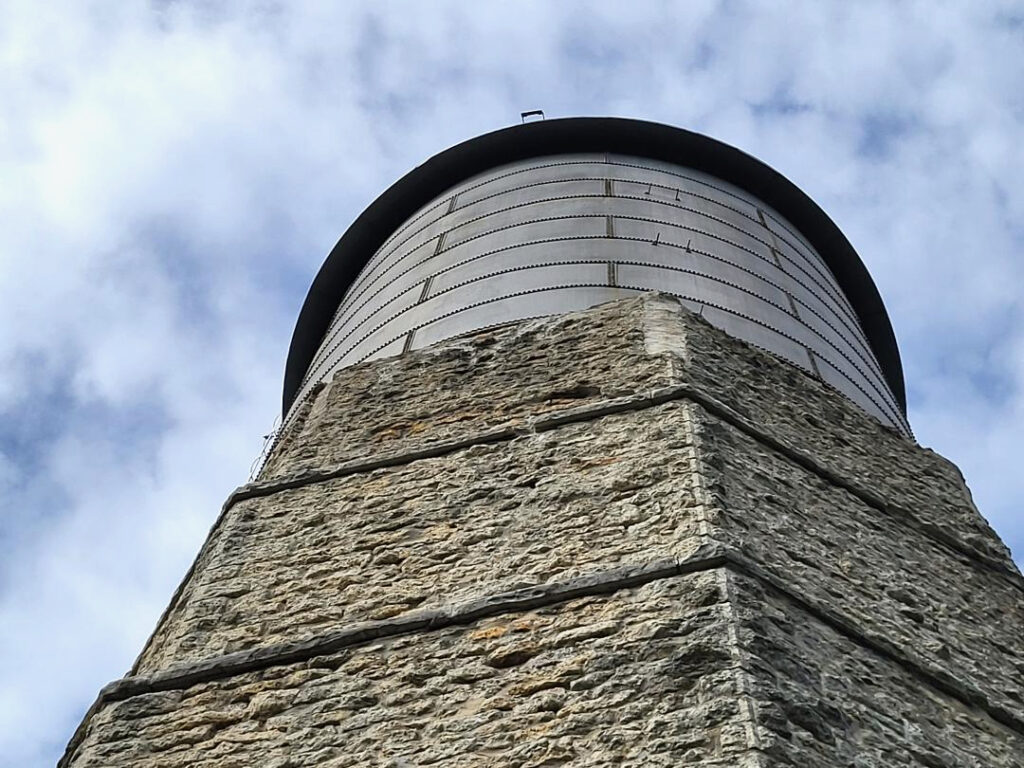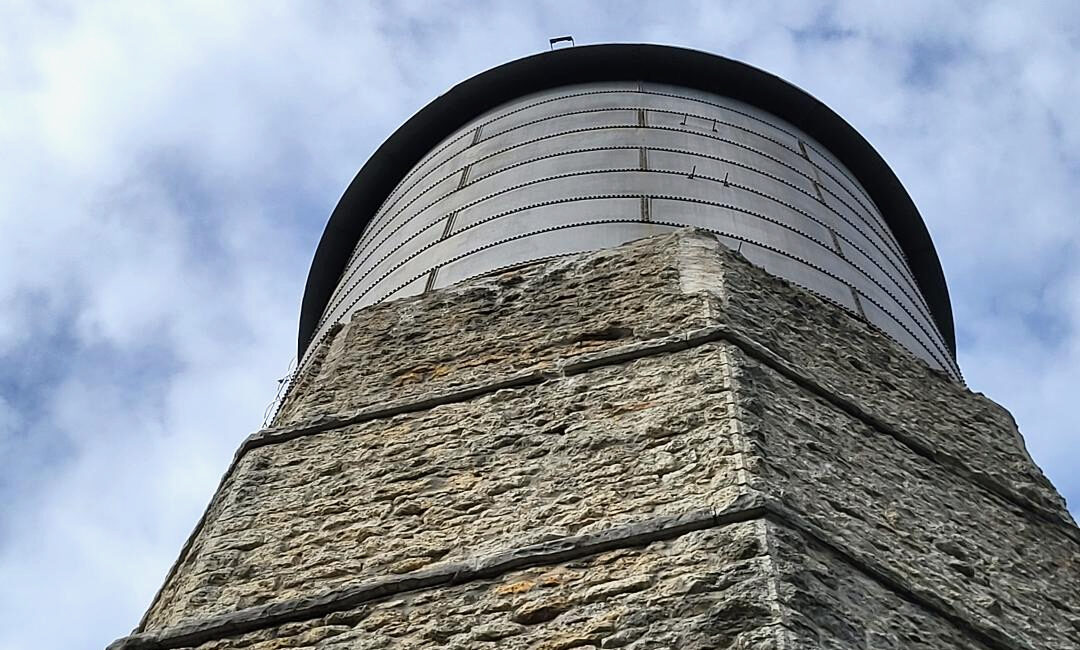By Kim McDarison
The Whitewater Common Council Thursday voted to send a report — indicating that between $600,000 and $1.5 million would be needed to either demolish or repair the historical water tower in Starin Park — to the Finance Committee for further evaluation.
The measure was decided by a 5-0 vote. Two council members, Jill Gerber and Lukas Schreiber, were not in attendance, but comments from both were read into the record by council President Lisa Dawsey-Smith in advance of the vote.
According to information presented Thursday by Public Works Director Brad Marquardt, a structural analysis report, produced by Wauwatosa-based McEnroe Consulting Engineers, noted that demolition of the historical water tower in Starin Park would cost approximately $600,000, while repair of the structure would cost between $1.1 million and $1.5 million, depending upon whether the work was done contiguously or in phases. A phased approach would command the higher price point, he said.
Structural analysis
Presenting information from the report to council, Marquardt noted that council authorized city staff to contract with McEnroe to perform the structural analysis of the tower last year, and the report was completed in January.
Information was first shared with the city’s Public Works Committee, Marquardt said, adding that information from that discussion was available in the meeting packet associated with Thursday’s council meeting.
Referencing the analysis, he said, “in general, the report indicates that the tower is in good condition.”
Still, he said, according to the report, “some elements are a little worse off than fair condition.”
Among “primary issued identified in the report,” Marquardt listed “stone cracking and deterioration, primarily at the belt course at each tier; cracked stone around the entry; bad mortar joints on the exterior and interior, and some of the steel supporting girders show corrosion.”
Marquardt next talked about costs and estimates, noting that he had contacted the Public Service Commission (PSC) to determine if any amount of the project’s costs could be paid by the city’s utility.
Marquardt said the PSC indicated that monies from the water utility could be spent up to the cost of demolition.
Looking at the cost of performing maintenance work and repairs, he said, McEnroe offered estimates between $950,000 and $1.1 million in 2023 dollars.
“That’s assuming if it was all done in one construction season. We do not have any money budgeted in 2023 for any of this work, so we would be looking at 2024 at the earliest if it would be the wishes of the council to maintain this tower,” Marquardt said.
As reported by Marquardt, the analysis also looked at doing the work using a three-phased approach.
“Basically to do work over three phases would add some costs to the project, raising it to what they (McEnroe) estimate to be about $1.5 million over those three-phased years,” Marquardt added.
He noted that the analysis also had been shared with the city’s Landmarks Commission.
After his presentation, Marquardt said he was looking to council for “some direction at some point.”
He asked: “How (do) we want to go about this — if we just want to accept the report and use it as a budgeting tool for future budgets or where (do) we want to go?”
Council discussion
Councilwoman Carol McCormick said that during the Public Works Committee meeting, she suggested the city might include a non-binding referendum regarding the tower on the upcoming April ballot, “just to get more of a broader picture of what the public feels about the reconstruction or demolition,” she said.
She noted receipt of “a lot of emails and a lot of talk about the tower,” adding that the issue had been added as a topic on the city’s online engagement Polco platform account, which, she described as “a very limited audience.”
Responding to questions from City Manager John Weidl, City Clerk Michele Smith noted that inclusion of a question on the April ballot was no longer an option as those ballots had already been ordered.
Dawsey-Smith next read statements from two council members who were not in attendance Thursday.
Reading from a statement provided by Gerber, she said: “Jill Gerber has indicated that she has done a fairly high level of analysis on other historical water towers throughout the state and did note that fundraising was done for all that had been preserved. She would hope that in the future, as anything was considered, there would be local quotes for potential for removal of the item if that was determined, and then would like to see the Finance Committee continue the discussion ahead of council for the implications on our capital improvement plan.”
Reading from a statement provided by Schreiber, Dawsey Smith said: “having been on the Landmarks Commission and reading the emails from the local historical society regarding the water tower, he would not be opposed to looking into keeping the water tower. He is for accepting the report into our records and looking into ways to possibly make it into a tourist attraction or implement it as a historical site. He thinks that the benefits of this discussion to keep the water tower outweigh the costs of maintaining it, but that is for a different agenda item, assuming that it would come back to us in the future to consider the cost of maintaining it and some possible ways to keep it standing. He would also not be opposed to an outside entity taking over the water tower if that were an option.”
Weidl asked Marquardt for specifics about a potential timeline.
Marquardt said McEnroe indicated that the condition of the tower was “safe.”
“The only issue that they see right now is rocks falling off the facade, which we do have the fence up which should alleviate that concern,” he said.
Weidl next asked Finance Director Steve Hatton if the $600,000, identified by the PSC as potentially coming from the city’s utility, could be seen as a “potential source of revenue” to “jumpstart” the tower’s preservation.
He asked: “How would that practically happen? Would that mean the utility would be taking on debt to do something like that, or in the event we demoed it, we would come up with the money and then effectively, the money would get transferred …”
Said Hatton: “We don’t have a cash-on-hand, so we’d have to explore ways to finance that, but, yes, if $600,000 of it — if a regulator would approve as the water utility’s share of —whether it’s demolition or if that’s used in a different way where they no longer have an ongoing financial obligation towards it — yes, we could explore different financing plans, but we do not have cash on hand to dedicate in that way.”
Following Hatton’s response, Weidl addressed council, saying: “at a minimum I’d like some time for staff … I’d like to use that $600,000 as a tool to have a thought about both how we would start the process of ensuring preservation — demolition is pretty straight forward — we send out the RFP (request for proposals) … but at least some time to toy with the numbers. We just kind of got ‘em and based on any feedback we get …”
Councilman Jim Allen said he was in support of a future referendum question, adding: “From the Public Works standpoint, I agree with Carol, that we thought there’s certainly time, that this item could wait five to 10 years, at such point when the city has funds to do something with it. Right now, of course, we don’t have any funds to do much of anything, to keep the services that we have. We have to be realistic about that. This would also give time for Landmarks, or whoever wants to take on the project, to do some fundraising, and lastly, I talked to several developers in town who would take it down for much less than $600,000.”
Approaching the podium from the gallery, Neil Hicks, who is running unopposed in April to fill an open Aldermanic District 5 seat, said he was in favor of the idea of placing a referendum question about the tower on an upcoming ballot. Incumbent Greg Majkrzak has announced he will not seek reelection in April.
“If you get three-fourths of the city to tell us what to do, then I guess it can’t be wrong,” Hicks said, adding that he believed there would likely be foundations that would consider funding maintenance for the tower, especially, he said, “if this is one of the oldest water towers in the state, as they’ve been saying.”
He also asked about an antenna which he believed was attached to the tower, citing potential for a need for licensing or regulatory approvals to move or maintain it.
Looking at potential placement for a non-binding referendum question, Weidl asked: “Michele (Smith) is the next election in fact in November?”
Smith responded that it was not, noting that opportunities would next come early next year.
Said Allen: “There’s no immediate hurry on this.”
Majkrzak said: “I share the thoughts of everyone. You know, it’s (historical water tower) really cool; I think it’s nice to have as part of our town. Having sat through the feedback on the (Cravath) lake (drawdown and restoration project), and the money that was invested, I think that adds a lot more value to this town than the water tower does. I think putting it on a ballot would be a really good choice. I love the idea of donations, but I think — I won’t be here when this decision’s made — but the ongoing maintenance and upkeep of this has to really be considered, because if this is a landmark of Whitewater, then it’s going to have to be a budgeted item that we’re going to have to spend money on.”
Councilwoman Brienne Brown asked if the $600,000 identified as potentially coming from the city’s utility could also be used to fulfill the requirements of any potential matching-funds grants for which the city might apply.
Dawsey Smith asked fellow council members if the questions raised and ideas posed were sufficient to constitute a framework which staff might use to further investigate options.
Weidl asked council if they were looking to have a non-binding referendum placed on the next available ballot.
Allen said he was in favor of waiting longer.
“We don’t have any foreseeable funds,” he said.
Said Dawsey Smith: “I would recommend that this item be taken to the Finance Committee as a part of the consideration of the capital improvement plan, and the changing landscape even interest rates are causing, so that there can be further investigation into the financial impact both to the utility or the taxpayer or whatever else may need to be considered, because there’s a substantial amount of information that still would have to be fleshed out, correct?”
The motion was approved.
Responding to questions raised about an antenna atop the tower, Marquardt said he would need to “double-check,” but, he said, “I believe that’s for our SCADA (supervisory control and data acquisition) system so we can send signals back and forth to the plant.”

Historical water tower in Starin Park, file photo.
This post has already been read 1075 times!
